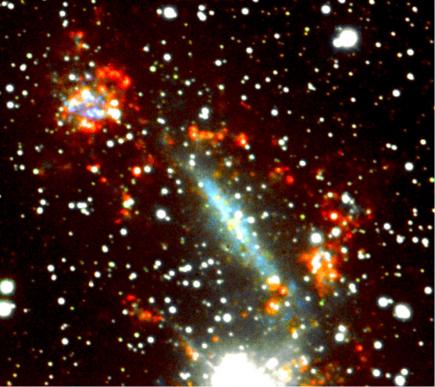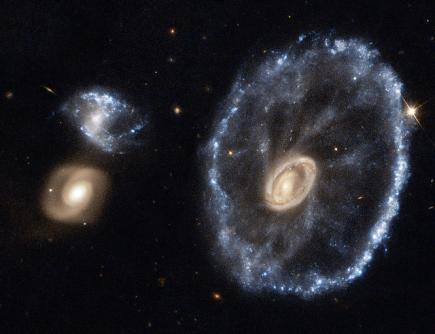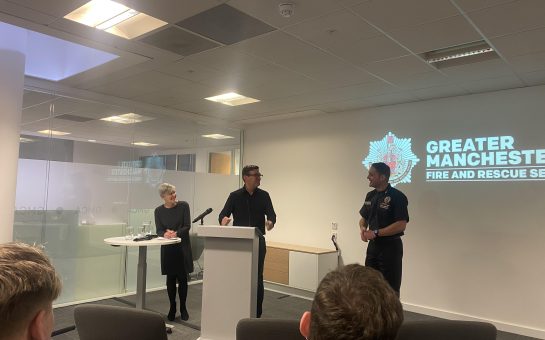Two galaxies near the Milky Way are colliding, producing a colourful firework display discovered by experts at the University of Manchester and the University of Hong Kong.
The small star systems, just 30 million light years away from Earth, are slamming into each other in what academics call a ‘bull’s-eye’ collision.
The shock-waves from the collision compresses gas to make new stars in each galaxy and create spectacular rings of intense light like a Catherine wheel on bonfire night.
The closest such system ever found, the discovery is announced today by a team of astronomers led by Hong Kong’s Professor Quentin Parker and Manchester’s Professor Albert Zijlstra.
Professor Zijlstra said: “This is a very exciting find because it will allow astronomers to study how collisions cause star formation, how long the collision takes, and what types of stars form.”

KATHRYN’S WHEEL: The new discovery has been named after the firework it looks like and Profeeor Zijlstra’s wife
The rare and beautiful spectacle has been named Kathryn’s Wheel because of its similarities to the famous firework, but also after Professor Zijlstra’s wife, Kathryn.
He said: “It is not often that you get to name any objects in the sky. But I think Kathryn’s Wheel is particularly fitting, resembling as it does a firework and continuing the tradition of naming objects after loved ones.”
Galaxies grow through collisions but it is rare to catch one in the process, and extremely rare to see a bull’s-eye collision in progress. Fewer than 20 systems with complete rings are known.
Kathryn’s Wheel was discovered during a special wide field survey of the Southern Milky Way undertaken with the UK Schmidt Telescope in Australia.
The rare jewel was uncovered during a search of the survey images for the remnants of dying stars in our Milky Way.
The scientists, who published their results in the journal Monthly Notices of the Royal Astronomical Society, were very surprised to also find this spectacular cosmic ring, sitting remotely behind the dust and gas of the Milky Way in the constellation of Ara.
Professor Parker said: “Not only is this system visually stunning, but it’s close enough to be an ideal target for detailed study.
“The ring is also quite low in mass – a few thousand million Suns or less than 1% of the Milky Way – so our discovery shows that collision rings can form around much smaller galaxies than we thought.”

DOING CARTWHEELS: Kathryn’s Wheel is forty time closer than this most famous example of a collisional ring galaxy (© NASA – ESA/Hubble)
The newly discovered ring galaxy is seven times closer than anything found before, and forty times closer than the most famous example of collisional ring galaxies, the Cartwheel Galaxy.
Kathryn’s Wheel is located behind a dense star field and close to a very bright foreground star, which is why it had not been noted before.
There are very few other galaxies in its neighbourhood – the odds of a collision in such an empty region of space are low.
Smaller galaxies are more common than large ones, implying that collisional rings could be ten times as common as previously thought.
The authors intend more detailed studies on larger telescopes since the system is currently the only one of its kind close enough to permit study in high detail.



